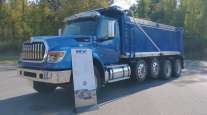Navistar Shows Off Alabama Plant Producing Heavy-Duty Engines
This story appears in the Nov. 8 print edition of Transport Topics.
HUNTSVILLE, Ala. — Navistar Inc. opened its new heavy-duty engine plant to journalists last week, showing where 114 employees are currently churning out 125 13-liter MaxxForce power plants a day.
The factory, adjacent to a Navistar medium-duty engine plant, is preparing to add the company’s new 15-liter engine to its line and to boost daily production to 150 a day, officials said.
Daniel Ustian, Navistar’s chairman and CEO, said he is “very, very much” satisfied with customer reception of its 2010 engines, which are the only ones being sold that utilize exhaust gas recirculation to meet federal emissions standards that went into effect this year.
Officials said they have more than 10,000 orders for ProStar Plus tractors equipped with the 2010 engines and that Navistar already has delivered more than 28,000 trucks in both heavy- and medium-duty classes equipped with 2010-compliant engines.
“We’re more comfortable than ever” with the company’s decision to use EGR to meet 2010 Environmental Protection Agency standards, said Tim Shick, director of engine sales for Navistar.
Company officials hosted a small group of journalists here on Nov. 3, a few days after a Navistar dealer meeting and a gathering of stock market analysts.
All other North American engine makers have chosen selective catalytic reduction for their products, which has set off a loud marketing debate between Navistar and the four other producers.
Ustian said he was surprised by his competitors’ focus on Navistar and its technology choice. “They’re all after us,” he said, and have focused their ad campaigns on Navistar’s choice of EGR in its MaxxForce brand.
“They make up worry beads for our customers,” he said of his competition. “It’s been a lot of effort” to counter those tactics, Ustian said.
He said that, while some customers still had concerns about the competing technology claims, customers in general have accepted Navistar’s EGR engine “faster than we had actually expected.” The engine applies an expanded version of the technology that all of the producers employed to meet several earlier Environmental Protection Agency emissions mandates.
Competitors’ SCR engines, however, add a urea-injection system to cleanse truck exhaust, but they also employ smaller EGR systems than Navistar now uses.
Ustian said customers aren’t worried about the specific nitrogen oxide output of the engines they buy, as long as they are EPA-certified.
Navistar is using emissions credits, which it has built up in prior years for exceeding federal standards, to help its current EGR engines meet EPA rules. Competing independent engine manufacturer Cummins Corp. also is using similar credits.
Ustian said Navistar was “100% of the way there” in producing an EGR engine that will meet the current EPA 0.2-gram NOx standard and would bring the engine to EPA for certification “in the next few months.”
He said the lower-emissions version of the EGR engine would apply higher fuel pressures but would feature the same fuel system as the existing model and would not produce more heat.
Ustian said the company expects the current engine to be its mainstay for several years and probably would offer the lower-emissions unit only to customers that had a specific need to meet the 0.2g EPA NOx standard.
“There’s nothing evil about EGR,” said Ramin Younessi, Navistar’s group vice president for product development and strategy. “Every manufacturer uses EGR” in its current engines, he added.
Younessi said he was confident that Navistar and its competitors could meet the federal government’s new mandate, announced last month, to cut carbon emissions from commercial trucks.
Ustian said Navistar is focusing on its 13-liter engine for its heavy-duty line, even as it moves to certify a 15-liter model it is developing in conjunction with Caterpillar Inc.
“We think the industry is going to 13 liters,” he said, because the new versions are able to match the output of previous versions of the larger models at lower purchase and operating costs than larger models. The smaller engines are lighter, leaving more weight for cargo.




